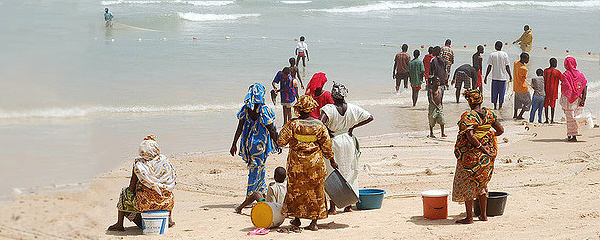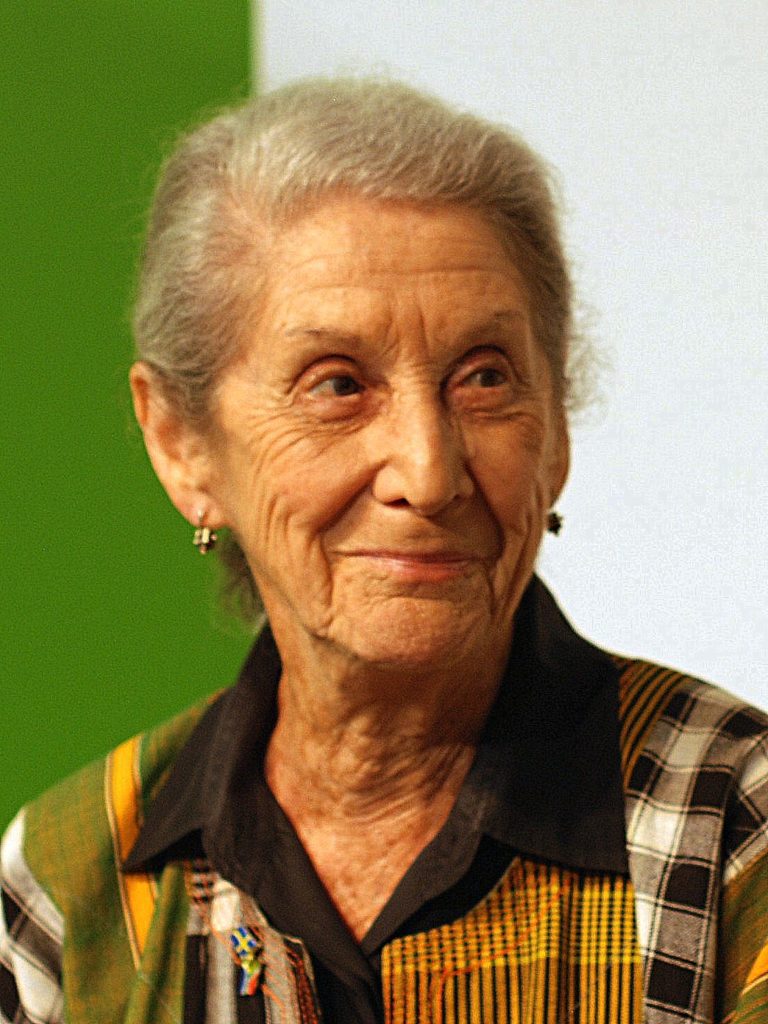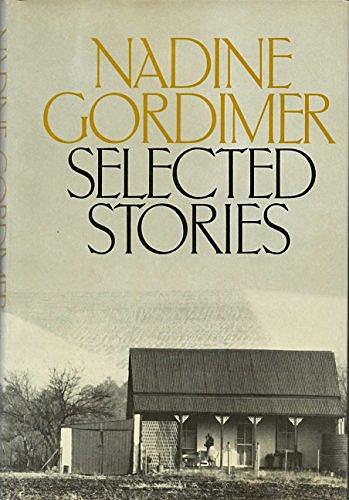
('Waiting for the Catch 2' © Tom Burke, 2007)
WE RECOMMEND: NADINE GORDIMER’S ‘THE CATCH’
by ALISON GIBBS
While Nadine Gordimer was known for both her fiction and her outspoken opposition to apartheid in her native South Africa, she always insisted that politics was not the driving motivation for her stories. ‘The real influence of politics on my writing is the influence of politics on people,’ she told The Paris Review in 1979. ‘Their lives, and I believe their very personalities, are changed by the extreme political circumstances one lives under in South Africa. So, I deal with people and here are people who are shaped and changed by politics.’

In her short story ‘The Catch’, we see what she called ‘the abstractions of politics through the flesh and blood of individual behaviour’ seeping through the lines. First published in 1952 in her third story collection, The Soft Voice of the Serpent, ‘The Catch’ was a relatively early work in a prodigious literary career that spanned more than six decades and earned Gordimer both the Booker Prize (1974) and the Nobel Prize for Literature (1991). South Africa’s apartheid system was also in its infancy: the first racial segregation legislation had been introduced just three years prior to the story’s publication. Nevertheless, the racial divide portrayed in ‘The Catch’ had been entrenched in South African society since colonial times, with whites, blacks and coloureds (Indian and other races) having little interaction beyond that of master and servant.
‘The Catch’ is set in a beach resort near Durban where a young white couple from Johannesburg is holidaying. During their idle mornings on the beach, they befriend an Indian fisherman, a relationship in which they initially luxuriate as a playful escape from the pressures of their lives:
The fact that he was Indian troubled them hardly at all. They almost forgot he was an Indian. And this too, though they did not know it, produced a lightening of the heart, a desire to do conversational frolics with a free tongue the way one stretches and kicks up one’s legs in the sun after confinement in a close dark room.
The situation quickly becomes problematic, however, when their own world intrudes in the form of friends visiting from the city and their ‘friendship’ with the fisherman places awkward demands upon them.
Like much of Gordimer’s fiction — short and long-form — ‘The Catch’ interrogates the complexities of white liberalism — attempts by well-meaning whites to overcome the colour bar which fail, not because of their personal ethic, but, as Gordimer told Studs Terkel in a 1962 interview, ‘because the society they exist in is based on an unethical premise’.
I’ve written usually about the borderland,…this half world where people do meet — black and white — but because of the general set-up around them, and other inequalities forced upon them, they tend just to go past, just to miss…I have written again and again about the moment of communication that doesn’t quite come off.
In ‘The Catch’, the beach and the holiday act as Gordimer’s ‘borderland’, the neutral ground on which such an interracial meeting can take place. The metaphor of the beach as democratic territory is developed throughout the story. Each time the couple leaves the sand, their attitude to the Indian changes, sometimes immediately, assuming the patronising conventions of white South Africa. Straight after celebrating his catch of a giant salmon and joyfully posing for photographs with the man and his fish, they head back to the resort:
“I don’t know how he’s going to manage to carry that great thing all the way to Bailey’s,” said the young man. He was steering his wife by her little nape.
“Oh, they’re strong. They’re used to it,” she said shaking her feet free of the sand as they reached the path.
By the time they are driving with their friends to Durban for dinner, their relationship with the fisherman has become an embarrassing aberration and his magnificent salmon a ‘great smelly fish’ in the boot of the car. The ‘brave moment of whole man’ who posed with his catch on the beach that morning is now ‘the poor old thing’, appearing diminished and beggar-like in the headlights of their car.
Written in the third person, ‘The Catch’ is told from the point of view of the young couple, most intimately that of the woman. This viewpoint is established immediately as we see at eye level, and in meticulous detail, the feet of the fisherman — ‘their Indian’ — thudding past them as they lie on the sand. In her later work, Gordimer was to fearlessly adopt the viewpoints of her black, coloured and male characters. In a 1983 article in The Paris Review, Gordimer described the diverse narrative voices in her acclaimed novel, Burger’s Daughter as intrinsic to the work, allowing her to explore relative truths in a racially polarised society. In 1952, however, when she wrote ‘The Catch’, she had only ever written from the perspective of white characters, most of them ‘females of sensitive consciousness’.
The narrative does, however, contain strong elements of omniscience: there are regular interjections like ‘although they did not know it’, and the nuanced recording of the young couple’s behaviour and responses is revealing of their subconscious selves. We, as readers, know more than the characters do. We grasp the double meaning in the girl’s remark about the fish being ‘more trouble than it’s worth’ while she feels only ‘a stab of cold uncertainty, as if she herself did not know what she had said, did not know what she had meant, or might have meant.’
Gordimer adds to this sense of remove by not naming her characters. With just one exception towards the end of the story when the woman calls her partner Les, they are referred to only as ‘the girl’, ‘the husband’ and ‘the Indian’. Her reasons for doing this are, to an extent, contained within the narrative:
They did not know his name, and now, although they might have asked the first day and got away with it, it was suddenly impossible, because he didn’t ask them theirs. So their you’s and he’s and I’s took on the positiveness of names, and yet seemed to deepen their sense of communication by the fact that they introduced none of the objectivity that names must always bring.
While this reflection on namelessness is pertinent, one also suspects that, rather than having agency, these three characters are playing out roles designated them by the society in which they live. As Gordimer said in 1979, ‘All this role playing that is done in a society like ours…You fall into it. It’s a kind of song-and-dance routine and you find yourself, and my characters find themselves, acting out these preconceived, ready-made roles’.
There is much to enjoy in the rich imagery and lyricism of the language that is characteristic of Gordimer’s earlier short fiction. In his 1974 essay ‘Cutting the Jewel: Facets of Art in Nadine Gordimer’s Short Stories’, Kevin Magarey cites ‘The Catch’ as representative of Gordimer’s method of making the central image-motif — in this case, the sea with its Freudian overtones of the unconscious — influence the imagery throughout: like sea creatures, the couple draw back the ‘tendrils of their friendship’ when the Indian asks if they’d like to buy his fish, and interest in the giant salmon ‘spread like a net, drawing in the few, scattered queer fish of the tiny resort’. The sensuous descriptions of the sun-glary beach and the dead fish lying on the sand are in stark contrast to the style of Gordimer’s later story collections like Loot (2003) in which the language is often spare and taut. As she, herself, explained in The Atlantic Monthly in 2000:
I think lyricism generally belongs to one’s early writings, before the narrative power has fully developed. As one gets more and more to the essence of things — as one goes deeper — one sheds the decoration, so to speak.
 Readers today might consider ‘The Catch’ unsubtle in terms of both its language and its loaded metaphor. In later stories like ‘Friday’s Footprint’ (1959), the setting also functions metaphorically, but it is much more sparsely described and is incorporated within the realist narrative. The handling of its themes of love and guilt is far less overt and the characterisation is more complex. Gordimer acknowledges this in her introduction to her Selected Stories (1976) in which both stories appear:
Readers today might consider ‘The Catch’ unsubtle in terms of both its language and its loaded metaphor. In later stories like ‘Friday’s Footprint’ (1959), the setting also functions metaphorically, but it is much more sparsely described and is incorporated within the realist narrative. The handling of its themes of love and guilt is far less overt and the characterisation is more complex. Gordimer acknowledges this in her introduction to her Selected Stories (1976) in which both stories appear:
…if the story has been achieved, the patronising backward glance its writer might cast upon it as something he could now do with one hand tied behind his back but no longer would care to do at all, will not detract from it.
She later reflected on how her striving to portray people in ‘the now’ placed an historical dimension on her development as a writer.
The change in social attitudes unconsciously reflected in the stories represents both that of the people in my society — that is to say history — and my apprehension of it; in writing, I am acting upon my society, and in the manner of my apprehension, all the time history is acting upon me.
As such, ‘The Catch’, in its simplicity and the almost childlike naivety of its white protagonists, is a story of its era. Already in place are the social constructs and some of the legislation that would propel the apartheid regime along its increasingly draconian path. But here, in 1952, these two young whites are still uncomprehending of their complicity in what she described to Studs Terkel as their society’s ‘unethical premise’: “But what have I said?” says the girl in the final line of the story, “Why are you laughing at me? What have I said?”
~

ALISON GIBBS has an MA in Creative Writing from the University of Technology, Sydney (UTS). Her short fiction has been published and broadcast in Australia and the UK and shortlisted for literary awards in both countries, including the 2013 ABR Elizabeth Jolley Prize. In 2015, she won the UTS Anthology Writing Prize for short story, presented at the Sydney Writers Festival. Alison is now working on her first novel with the help of a Varuna PIP Fellowship. She runs her own writing consultancy in Sydney, producing materials for international aid and human rights organisations.

